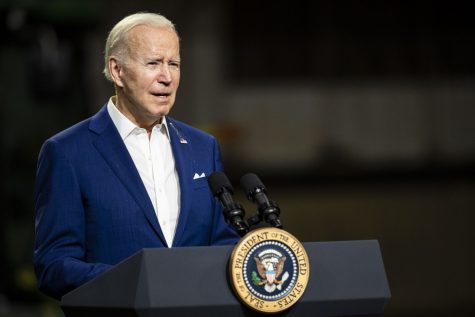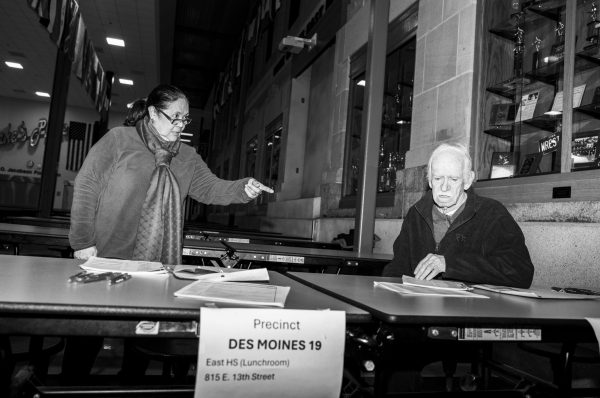How many tickets out of Iowa? New caucus rules could allow multiple candidates to claim momentum out of Iowa
A caucus leader helps an Iowa resident check into the Democratic caucus at the Celebration Farm in Iowa City on Feb. 1, 2016.
January 27, 2020
On caucus night 2012, eight votes separated the declared “winner” of the Republican caucuses — Mitt Romney — from the next closest contender — Rick Santorum. Sixteen days after the caucuses, the Iowa Republican Party reversed themselves, saying Santorum actually came away from the caucuses with 34 more votes.
The new result shaped political-pundit commentary and media coverage for the rest of the race. The actual number of delegates each candidate took on to the national convention from the Hawkeye State remained the same, but Romney, the eventual nominee, couldn’t hammer his line that he was the first nonincumbent Republican to win both the Iowa caucuses and the New Hampshire primary since 1976. The Santorum campaign could prove Romney wasn’t unbeatable.
On Feb. 3, 2020, more than one Democratic presidential hopeful could declare themselves the “winner” of the Iowa caucuses because of new result-reporting rules of the Iowa Democratic Party.
The rules, which were meant to add transparency to the Iowa Democratic caucus process after complaints in 2016, could muddle the results in media reporting and allow candidates to make competing claims for momentum out of Iowa.
The party will release three different metrics for candidates’ support on Feb. 3 — a raw total of caucusgoer support, a second reshuffling, and the final state delegate equivalents. With a handful of Democrats jockeying at around 20 percent support in the most recent Iowa Poll, there’s a possibility that different candidates could win each measure of support.
The national Democratic convention won’t be swayed by Iowa’s 41 pledged delegates — the Democratic National Committee parcels out a total of 3,989 pledged delegates to all 50 states. Higher-volume Super Tuesday states California and Texas send 415 and 228 delegates, respectively, to the nominating convention.
Despite the state’s relatively small delegate count, candidates benefit from media coverage if they perform better than expected in Iowa, the first state on the nominating calendar. Jimmy Carter was the first candidate to campaign heavily in Iowa, and came in second in 1976 to “uncommitted.” The unexpected result propelled Carter through the rest of the primary calendar to win the White House, and marked a trail for future unknown presidential contenders to use Iowa as a launch pad.
In 2016, Clinton won the caucuses by four delegates. The party fielded criticism from Sanders supporters after some precincts flipped coins to determine the support of a delegate. The coin flips didn’t affect the final results of the Iowa caucuses, but critics wondered how delegates could be decided by an archaic game of chance.
Now, with two added metrics, candidates have more opportunities to claim they did well in Iowa. A candidate winning all three measures would be the simplest narrative, but with four candidates neck-and-neck in the polls, different candidates winning different metrics is a possibility, Yepsen said.
The candidate with the most supporters on the first alignment — the raw total — can say he or she would’ve won if Iowa held a primary.
The party will also report the results of the second and final alignment, which is the tally of candidate supporters after caucusgoers who backed a nonviable candidate leave or choose another Democrat to support. The Democratic candidate with the top tally of support in this metric could claim to appeal to the most Iowans and form the broadest coalition of voters in the general election.
Lastly, the top state delegate equivalent-getter would be able to tout their organizing strength throughout the state. Campaigns have to be strategic to win over the most delegates, an important part of mobilizing a campaign in a general election against President Trump. In the 2016 election, Clinton won the popular vote, but now-President Trump won the electoral college and the presidency.
Linn County Democratic Chair Bret Nilles said he thought organizing prowess would be a key element in describing the results.
“If you got someone who wins, say, the initial count from the first alignment and they don’t do as well in the delegate count — the discussion might be that they were able to get people out, but they don’t have the organization to win the nomination,” Nilles said.
He added that it’ll be crucial for volunteers on the ground to understand the rules, because just a few delegates could determine the winner.
Madalyn Anderson, the Democratic county chair in Story County, said the only metric that will truly decide the winner is the delegate count. She said the different metrics will be telling of a candidate’s support — such as which candidate turns out the raw vote and which candidate gains the most support from the first alignment to the second alignment — but emphasized that the purpose of the added result types is for transparency.
“It all comes down to how many delegates end up at the convention in Milwaukee,” Anderson said. She added that there might not be a true, clear winner, because there’s a possibility multiple candidates will have close delegate counts.
Anderson said the biggest change to the caucusing process this year is that once you’re in a viable group, you cannot move to support another candidate, which includes the undecided category.
“In the past it could be that if there’s a bunch of people who didn’t show up to the county convention, delegates actually could be lost, and [the delegate count is] a static number now,” Anderson said.
The Associated Press reported it would declare the winner based on the number of state delegate equivalents candidates garner, as the national convention would be decided by a delegate count.
As the two state parties look to hold onto the state’s first-in-the-nation status, a muddled result could give critics of Iowa as the bellwether of the presidential primary another reason to forgo the caucuses.
“You’ve got five candidates who are going to be saying, ‘Hey, we won something here’ and that’s where then what will occur is an incredible amount of spin,” Yepsen said.
“‘I got the most delegates.’ ‘I got the most raw body count votes.’ ‘I came close.’ ‘I got one of the three tickets out of here.’ ‘No, there’s really four tickets this year.’ And if that result is like that it will mean there aren’t going to be clear winners and clear losers.”
Politics Editor Julia Shanahan and Politics Reporter Caleb McCullough contributed reporting.















